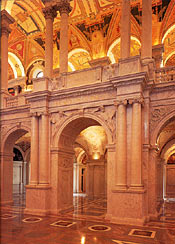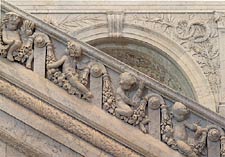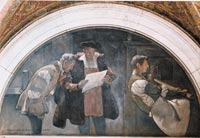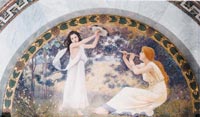First Floor of the Thomas Jefferson Building
 The
Library's Jefferson Building faces the Capitol of the United States on
the First Street side. The Main Entrance to the building's first floor
consists of three double, bronze entrance doors, weighing a total of 3
tons, depict Tradition, Writing and Printing
(shown in the image on the right). They represent how history,
religion, literature and science have been preserved and disseminated
by man. The doors were modeled by Frederick MacMonnies, Olin L. Warner
and Herbert Adams and are now opened only for special occasions. The
Library's Jefferson Building faces the Capitol of the United States on
the First Street side. The Main Entrance to the building's first floor
consists of three double, bronze entrance doors, weighing a total of 3
tons, depict Tradition, Writing and Printing
(shown in the image on the right). They represent how history,
religion, literature and science have been preserved and disseminated
by man. The doors were modeled by Frederick MacMonnies, Olin L. Warner
and Herbert Adams and are now opened only for special occasions.
After entering the building from these doors, or coming up one flight
of stairs from the Ground Floor Visitors' Entrance, you will find yourself
in the West Corridor of the Library's ornate Great Hall, also known as
the Vestibule
West Corridor, or Vestibule, of the Great Hall
 The
West Corridor on the First Floor of the Library of Congress' Jefferson
Building serves as the Vestibule to the Great Hall (pictured in the
image on the left). The Great Hall is constructed of white Italian
marble and occupies a large portion of the front of the building. The
West Corridor on the First Floor of the Library of Congress' Jefferson
Building serves as the Vestibule to the Great Hall (pictured in the
image on the left). The Great Hall is constructed of white Italian
marble and occupies a large portion of the front of the building.
The stucco ceiling of the Vestibule is accented with 23 karat gold leaf.
Around the border of the ceiling stand eight pairs of statues (seen
directly above the columns in the image on the left) representing
the Goddess Minerva. The work of Herbert Adams, each pair contains a Minerva
of War -- carrying the torch of learning in one hand and a falchion, or
short, stout sword, in the other -- and the Minerva of Peace -- carrying
a globe, signifying the universal scope of knowledge, and a scroll. Minerva
and the owl, her symbol, are repeated throughout the Great Hall.
The Great Hall
 Once
in the Great Hall, you will be able to appreciate the grandeur of the architecture.
The ceiling, 75 feet above the marble floor, is decorated with stained glass
skylights supported by elaborately paneled beams finished in aluminum leaf.
In the center of the marble floor is a large brass inlay shaped like a sun,
on which are inscribed the four cardinal points of the compass. Bordering
the sun on four sides are round medallions with 12 brass inlays representing
the signs of the zodiac. In niches on the west side of the hall are two
bronze masks formerly used as drinking fountains. Once
in the Great Hall, you will be able to appreciate the grandeur of the architecture.
The ceiling, 75 feet above the marble floor, is decorated with stained glass
skylights supported by elaborately paneled beams finished in aluminum leaf.
In the center of the marble floor is a large brass inlay shaped like a sun,
on which are inscribed the four cardinal points of the compass. Bordering
the sun on four sides are round medallions with 12 brass inlays representing
the signs of the zodiac. In niches on the west side of the hall are two
bronze masks formerly used as drinking fountains.
On the east side is the Commemorative Arch leading back to the Main Reading
Room (pictured in the image on the right). Inscribed into the frieze
above are the words Library of Congress. Above that, flanked
by eagles, is a tablet with the names of the engineers and architects
who were responsible for the design and construction of the Jefferson
Building.
 Two
grand staircases that display the work of sculptor Philip Martiny flank
the Great Hall (one of these staircases is shown in the image to the
left). Upon the newel post at the base of the railing of each staircase
stands an unnamed, larger-than-life-size bronze female figure holding
aloft a torch. Be sure to look closely at the marble figures carved into
the outside of the railings. These putti, or small children,
complete with the tools of their trade, represent the various occupations,
habits and pursuits of "modern life": a musician with lyre and music book;
an electrician holding a telephone; and an entomologist, with specimen
box and butterfly net; among others. Note especially the two figures flanking
globes halfway up the staircase on each side. On the south side of the
hall are represented Africa and America, with those continents shown on
the globe between them; on the north side are Europe and Asia. Two
grand staircases that display the work of sculptor Philip Martiny flank
the Great Hall (one of these staircases is shown in the image to the
left). Upon the newel post at the base of the railing of each staircase
stands an unnamed, larger-than-life-size bronze female figure holding
aloft a torch. Be sure to look closely at the marble figures carved into
the outside of the railings. These putti, or small children,
complete with the tools of their trade, represent the various occupations,
habits and pursuits of "modern life": a musician with lyre and music book;
an electrician holding a telephone; and an entomologist, with specimen
box and butterfly net; among others. Note especially the two figures flanking
globes halfway up the staircase on each side. On the south side of the
hall are represented Africa and America, with those continents shown on
the globe between them; on the north side are Europe and Asia.
East Corridor
 The
East Corridor features a vaulted ceiling is covered with mosaics honoring
Americans and their achievements in a variety of professions: painting,
poetry, engineering, natural philosophy, architecture, natural science,
music, sculpture and astronomy. Along the central portion of the ceiling
are three medallions depicting the professions of theology, law and medicine. The
East Corridor features a vaulted ceiling is covered with mosaics honoring
Americans and their achievements in a variety of professions: painting,
poetry, engineering, natural philosophy, architecture, natural science,
music, sculpture and astronomy. Along the central portion of the ceiling
are three medallions depicting the professions of theology, law and medicine.
John White Alexander's six paintings in the semicircular areas below
the vaulted ceilings illustrate The Evolution of the Book. As
you stand looking into the Great Hall, notice the progression, left to
right, from human memory to the spoken, written and printed word in human
history. Beneath the painting of The Printing Press, depicting
Johann Gutenberg (pictured in the image above right), is a memorial
to the men of the Library of Congress who died in World War I.
 Two
of the Library's great treasures, the Gutenberg Bible (shown
in the image on the left) and the Giant Bible of Mainz, are
displayed in separate cases here in the East Corridor. Both volumes were
produced in Mainz, Germany, in the mid-1450s; one is written by hand,
in manuscript, while the other is the first book printed with movable
metal type. The Library's three-volume Gutenberg Bible is one of three
perfect vellum copies in existence. Two
of the Library's great treasures, the Gutenberg Bible (shown
in the image on the left) and the Giant Bible of Mainz, are
displayed in separate cases here in the East Corridor. Both volumes were
produced in Mainz, Germany, in the mid-1450s; one is written by hand,
in manuscript, while the other is the first book printed with movable
metal type. The Library's three-volume Gutenberg Bible is one of three
perfect vellum copies in existence.
In the rear of the East Corridor is the former entrance to the Main Reading
Room, with paintings by Elihu Vedder depicting good and bad government
and the effects of each: Anarchy, Corrupt Legislation,
Government, Good Administration and Peace and Prosperity.
North Corridor
 The
paintings in the North Corridor by Charles Sprague Pearce represent the
themes of a well-ordered and idyllic existence: The Family, Recreation,
Study, Labor, Religion and Rest. You
will also find the names and service dates of all the Librarians of Congress
inscribed on the wall below the group portrait of The Family
(the painting on the right is entitled "Recreation").
To the left of the engraving is a small doorway, above which is carved
the word Librarian. This is the entrance to The Librarian's Room
(once the office for the Librarian of Congress), now used only for ceremonial
occasions. The
paintings in the North Corridor by Charles Sprague Pearce represent the
themes of a well-ordered and idyllic existence: The Family, Recreation,
Study, Labor, Religion and Rest. You
will also find the names and service dates of all the Librarians of Congress
inscribed on the wall below the group portrait of The Family
(the painting on the right is entitled "Recreation").
To the left of the engraving is a small doorway, above which is carved
the word Librarian. This is the entrance to The Librarian's Room
(once the office for the Librarian of Congress), now used only for ceremonial
occasions.
Special In-Depth Tour:
The Librarian's Room can be viewed
in detail through a special "in-depth" tour.
|
The corridor to the right leads to three special-purpose rooms where
portions of the libraries of Ralph Ellison, Oliver Wendell Holmes and
Woodrow Wilson can be seen by special arrangement.
South Corridor
Here the paintings by Henry Oliver Walker honor poets. The names of American
poets, Longfellow to Poe, appear in wreaths in the mosaic of the vaulted
ceiling on the north side; ancient and non-American poets, Theocritus
to Ronsard and Browning to Heine, can be found in the central medallions
and the wreaths on the south side.
 An
idyllic summer landscape occupies the west end of the corridor with three
seated female figures and a youth representing the moods of lyric poetry.
Wordsworth's words about poets are painted in the streamer over the landscape.
For the smaller lunettes on the north and south walls, Walker has painted
single youthful male figures suggested in various poems by English and
American poets: Milton and Shakespeare on the north wall and Tennyson,
Keats, Wordsworth and Emerson on the south side of the corridor. The mural
at the eastern end of the corridor shows Lyric Poetry surrounded
by her attributes -- Pathos, Truth, Devotion, Passion, Beauty and Mirth
(shown on the left). Inscribed in the marble beneath this painting
is a memorial to the men of the Library of Congress who died in World
War II. The corridor to the right, with The Members of Congress Room and
the Congressional Reading Room, is reserved for the use of members of
Congress. An
idyllic summer landscape occupies the west end of the corridor with three
seated female figures and a youth representing the moods of lyric poetry.
Wordsworth's words about poets are painted in the streamer over the landscape.
For the smaller lunettes on the north and south walls, Walker has painted
single youthful male figures suggested in various poems by English and
American poets: Milton and Shakespeare on the north wall and Tennyson,
Keats, Wordsworth and Emerson on the south side of the corridor. The mural
at the eastern end of the corridor shows Lyric Poetry surrounded
by her attributes -- Pathos, Truth, Devotion, Passion, Beauty and Mirth
(shown on the left). Inscribed in the marble beneath this painting
is a memorial to the men of the Library of Congress who died in World
War II. The corridor to the right, with The Members of Congress Room and
the Congressional Reading Room, is reserved for the use of members of
Congress.
To continue your tour, proceed to the Second
Floor of the Thomas Jefferson Building.
 Library of Congress
Library of Congress
Contact Us (
April 23, 2003
)
|

